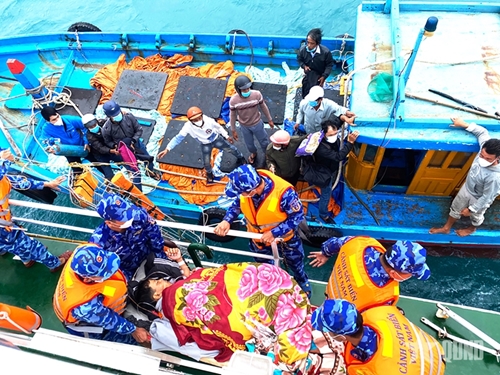Silent feats-of-arms
According to Senior Captain Ho Ba Dung, Captain of Ship CSB 6001, Naval Squadron 211, Flotilla 21, Coast Guard Region 2, the period from late May to October witnesses the highest number of maritime accidents due to storms and heavy rainfall. Therefore, officers and soldiers aboard Ship 6001 consistently uphold their sense of responsibility and remain prepared to carry out SAR missions to protect the lives and property of fishermen when needed.
    |
 |
|
Rescuing troubled fishermen at sea |
SAR missions often occur during periods of strong winds and high waves. However, whenever the order is given, coast guard personnel promptly rush to the scene to rescue victims, provide medical care, supply fuel, and tow distressed fishing vessels to safety, helping reduce loss of life and property among seafarers.
Ensuring adequate personnel and equipment
Vietnam is a coastal nation situated in a region frequently affected by natural disasters, particularly storms, tropical depressions, and rising sea levels. According to Senior Colonel Dao Ba Viet, Deputy Commander of the Vietnam Coast Guard Command, the Command has implemented stringent measures to prevent, respond to, and recover from the consequences of natural disasters and to conduct SAR operations. It maintains a high level of readiness, closely monitors evolving situations, and promptly deploys forces nationwide for necessary missions.
    |
 |
|
Coast guards approach the distressed fishing vessel at sea. |
Under the close direction of the Party Committee and the Vietnam Coast Guard Command, relevant agencies and units have worked with other forces to collect and process information, and timely provide recommendations to higher authorities on effective disaster response and SAR measures.
Senior Colonel Truong Ba Long, Chief of Staff of Coast Guard Region 2, shared that to successfully execute SAR missions, the region has proactively collaborated with other forces, ensured personnel readiness, maintained operational equipment, and prepared contingency plans for search and rescue, disaster response, and maritime environmental protection. The region also focuses on improving training quality, mastering modern technical equipment, enhancing maneuverability, conducting SAR drills, and combining training with exercises, while ensuring absolute safety during mission execution.
At present, amid increasingly complex developments in natural disasters, and in line with the directives of the Party, State, Central Military Commission, and the Ministry of National Defense, as well as international obligations under the 1979 International Convention on Maritime Search and Rescue (SAR-79), coast guard agencies and units have strengthened legal education and public awareness. They also provide guidance on handling maritime incidents involving ships and boats and raise awareness among officers and soldiers about the principles, strategies, and viewpoints related to disaster response and emergency operations.
    |
 |
|
The Vietnamese and Korean coast guard forces practice search and rescue operations in RoK’s waters. |
Coast guard units have regularly reviewed, updated, and supplemented their response plans and conducted practical exercises to improve their readiness for emergencies, natural disasters, and SAR operations.
They maintain a high state of readiness, closely monitor the progression of disasters and incidents, and fully prepare personnel and equipment for deployment under any condition. They also coordinate with local authorities and other relevant forces in responding to emergencies and natural disasters.
Furthermore, the Vietnam Coast Guard has consistently expanded international cooperation with other countries and regional organizations to enhance its humanitarian search and rescue capabilities—especially in operations involving foreign vessels in Vietnamese waters.
Translated by Quynh Oanh